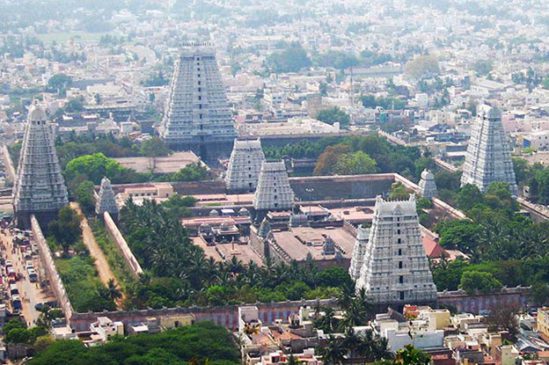Pancha Bhoota Sthalam refers to the five Shiva temples dedicated to Shiva, each representing the manifestation of the five prime elements of nature- earth, water, air, sky, fire. Pancha indicates Five, Bhoota means elements and Sthalam means place. All these temples are in South India with four of these temples in Tamilnadu and one in present-day Andhra Pradesh. The five elements are believed to be preserved in the five lingams and each shiva lingam has a distinct name based on the elements they represent.
1. Sky – Chidambaram Temple – where the Lord is worshipped in his manifestation as Sky
2. Water – Thiruvanaikaval Jambukeshwara Temple, Trichy – where the Lord is worshipped in his manifestation as Water
3. Earth – Kanchi Ekambareswara Temple, Kanchipuram – where the Lord is worshipped in his manifestation as Earth
4. Fire – Thiruvannamalai Arunachaleswara (Annamalaiyar) Temple, Thiruvanna malai – where the Lord is worshipped in his manifestation as Fire
5. Air – Kalahasti Nathar, Kalahasti Temple – where the Lord is worshipped in his manifestation as air/wind.
The five temples were built according to the yogic sciences, and are placed in a certain geographic alignment with each other so that the entire region resonated with the possibility they offered.
Out of these five temples, three temples (Kalahasti Temple, Ekambareswara Temple, and Chidambaram Temple) are in geographical straight line. All 3 temples are constructed at least 1000 years ago. No satellite technology was present at that time. Even then accurate positioning of these temples shows these temples are truly an engineering, astrological and geographical wonder.
1.Chidambaram Temple –
Chidambaram Temple is a Hindu temple dedicated to Lord Shiva located in the heart of the temple town of Chidambaram in Tamil Nadu. The temple is situated at a distance of 78 km from Pondicherry and 235 Km from Chennai. There have been several renovations in its history, particularly during the days of Pallava and Chola emperors in ancient and pre-medieval periods.
The temple complex spread over 50 acres. It is an ancient and historic temple dedicated to Lord Shiva Nataraja and Lord Govindaraja Perumal, one of the few temples where both the Shaivite and Vaishnavite deities are enshrined in one place.
The word Chidambaram may be derived from chid, meaning “consciousness”, and ambaram, meaning “sky”; it refers to the chidaakasam, the sky of consciousness, which is the ultimate aim one should attain according to all the Vedas and scriptures.
2. Jambukeshwara Temple –
Jambukeshwara Temple is a famous Shiva temple in Tiruchirapalli (Trichy), in the state of Tamil Nadu, India. The temple was built by Kocengannan (Kochenga Chola), one of the Early Cholas, around 1,800 years ago. It is in the Srirangam island, which has the famous Ranganathaswamy temple.
This temple represents the element of water. The sanctum of Jambukeswara has an underground water stream and despite pumping water out, it is always filled with water.
3. Annamalaiyar Temple –
Arunachaleswara temple is a Hindu temple dedicated to Lord Shiva, located at the base of Annamalai hills in the town of Thiruvannamalai in TamilNadu. This temple is believed to be the largest temple in the world dedicated to Shiva. It is significant to the Hindu sect of Saivism as one of the temples associated with the element of fire or Agni. Shiva is worshiped as Annamalaiyar or Arunachaleswarar and is represented by the lingam, with his idol referred to as Agni lingam. His consort Parvati is depicted as Unnamalai Amman. The Karthigai Deepam festival is celebrated during the day of the full moon between November and December, and a huge beacon is lit atop the hill. It can be seen from miles around and symbolizes the Shiva lingam of fire joining the sky.
4. Srikalahasti Temple –
Srikalahasti Temple is a Hindu temple dedicated to Lord Shiva, located in the town of Srikalahasti in Andhra Pradesh. It is one of the most famous Shiva temples in South India.
Srikalahasti temple, situated 36 km away from Tirupati is famous for its Vayu linga, one of the Panchabhoota Sthalams, representing wind. The temple is also regarded as Rahu Ketu kshetra because of famous Rahu-Ketu pooja. The inner temple was constructed around the 5th century and the outer temple was constructed in the 12th century by the Chola kings and the Vijayanagara kings.
Lord Shiva in s worshiped as Kalahasteeswara with respect Vayu element. This is the only temple in India which remains open during Solar and lunar eclipses, while all other temples are closed. This temple is famous for Rahu-Ketu pooja. It is said that performing Rahu-Ketu pooja will remove the astrological effects of Rahu and Ketu. This temple is considered as “Kashi of the South”.A flickering lamp in the Srikalahasti temple shows the play of wind. The temple is also known Dakshina Kailasam.
5. Ekambareswarar Temple (Ekambaranathar Temple) –
Ekambareswarar Temple is a Hindu temple dedicated to the deity Shiva, located in the town of Kanchipuram in Tamil Nadu, India. It is significant to the Hindu sect of Saivism as one of the temples associated with the five elements, the Pancha Bhoota Stalas, and specifically the element of earth, or Prithvi. Shiva is worshiped as Ekambareswarar or Ekambaranathar and is represented by the lingam, with his idol referred to as Prithvi lingam. The Lingam made of sand at Kanchipuram represents the Siva’s association with the Earth element.
If you liked the story, Please share with your friends.








1 comment
Simply wanna comment that you have a very decent website , I love the pattern it really stands out.